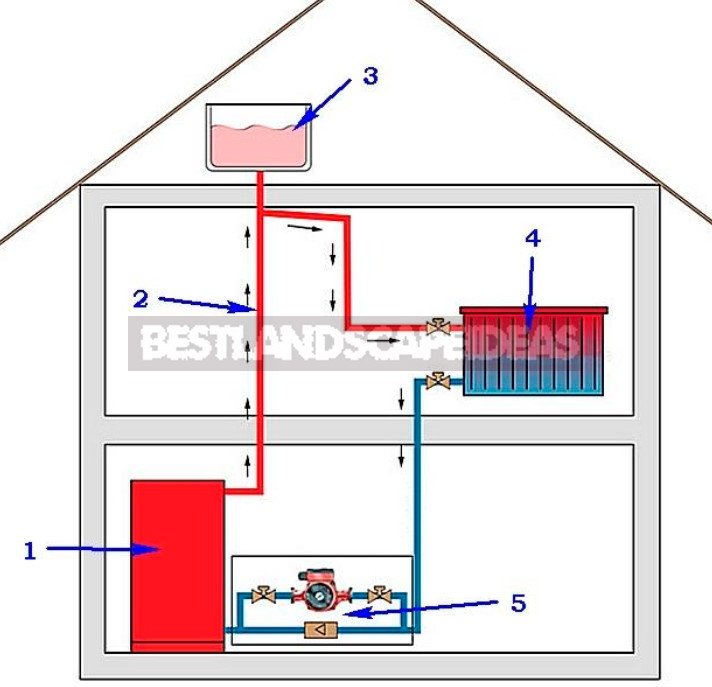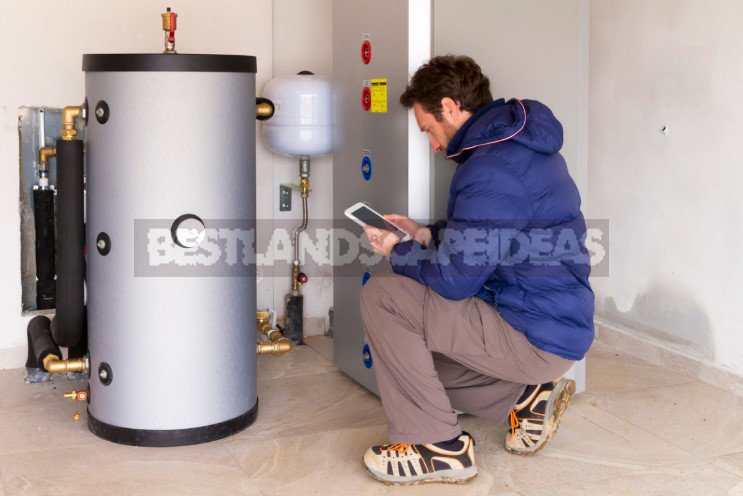
Those who assemble and install the heating system themselves often wonder how to install the expansion tank correctly. To do this, it will be more useful to understand what an expansion tank is in general and why it is needed.
Therefore, we will sort everything out in order, and first we will remember the physics lessons.
Physical properties of water
One of the physical properties of water is its almost zero compressibility. This means that when you try to reduce its volume (that is, compress it), there is a sharp increase in pressure.
And water (like other materials) can increase its volume when heated. This property is called thermal expansion. In water, it starts at a temperature of +4°C (39.2°F). However, when the temperature drops below this mark, the water also begins to expand. This phenomenon is called the water paradox. At a temperature of +4°C (39.2°F), water has the highest density: the weight of one liter is one kilogram.
However, this paradox is not important for heating systems, since the temperature of the water supplied by the boiler to the radiators is much higher.

Take a container with overflow, which limits the volume equal to 1000 cubic centimeters (32.8 cubic ft). Pour into it one liter of water having a temperature of + 4°C (39.2°F), and then proceed to heating. The density of the water will begin to decrease, and the volume will increase.
Since overflow limits a known volume, an excess of water is formed as a result. When heated from +4 °C to + 90 °C (39.2-194 °F)( (normal water temperature in the heating system), this excess will be 39.95 cm3/15.7 in3 (or 34.7 grams/1.2 oz). It is this process that occurs in the heating system when the boiler heats the water.
What is the expansion tank
Remember: if we try to compress the water (that is, in our case, to accommodate an increased amount of coolant in a given volume of the heating system), the pressure will increase. So that the excess water formed during heating does not spoil the pipes and appliances, you need to drain it somewhere, as in a measuring container in the experiment.
But we can’t drain the water from the heating system. So, the excess should be temporarily “put” in some “pocket” so that later, when the temperature of the water decreases and its density increases, it returns to the system, and the water occupies the same volume as it was originally.

In the heating system, an expansion tank is such a “pocket” that receives excess water formed during thermal expansion. Its task is to be a pressure compensator in the system.
Open and closed expansion tanks
Expansion tanks can be open and closed. That is, communicating with the atmosphere or with a controlled one, by changing the pressure.
Open expansion tank
The glass from the described experiment, as a result of which an excess of water was formed during thermal expansion, is the simplest open expansion tank. Its disadvantage is that the spilled water must be returned to the system in manual mode. Simply put, we pour it back into the container in which the water was heated.
Naturally, such a primitive method is not suitable for a heating system.
An open expansion tank can either be purchased ready-made, or manufactured independently. Any container of the required volume, for example, a plastic canister, is suitable for this.
Closed expansion tank
Now they are trying to use closed tanks more often: they are more compact and devoid of the negative features of open ones, which are characterized by freezing, oxygen saturation of the coolant, increased corrosion. Closed tanks are sealed and consist of two chambers: water and air.
Pressure compensation occurs as follows: excess water fills the water compartment and presses on the elastic partition between the two chambers, and the air (or gas) in the air compartment is compressed. Unlike water, gas can be subjected to significant compression without a strong increase in pressure.

There are two types of closed expansion tanks available for sale, which differ in their device:
- with disc-shaped membrane;
- pear-shaped membrane.
How to install the expansion tank in the heating system
Having dealt with the theoretical foundations and types of compensation tanks, we turn to the main question: how to install an expansion tank in a heating system. And how to choose the right place for this.
The correct answer is where you want it. That is, the expansion tank can be installed on the “feed” – the main line of the system leading from the boiler to the heating devices, and on the “return” – the pipe through which the coolant returns to the heating device (boiler), giving its heat to the radiators. It will perform its function of a buffer that restrains the growth of pressure in any case.

Both methods have their pros and cons. The installation location is selected based on the design features of a particular heating system. As well as the convenience of installation and subsequent maintenance.
Nuances
An open tank, unlike a membrane one, can be installed in a system with natural water circulation, that is, in a non-volatile one that does not require electricity. Pressure formation is necessary in the system. Therefore, the open expansion tank is installed at the highest point above all heaters.
Most often, this point is located in the attic. Today, when the basement in private homes also involves the arrangement of a living room, this option is often inappropriate.
There are no restrictions on the placement of a closed tank. It can stand in any convenient place and in any position.

Installation diagram of an open expansion tank. 1-boiler, 2 -coolant supply line, 3 – open expansion tank, 4 -heating device, 5-pumping unit.
Although the membrane tank can be installed both before and after heating devices, it is usually installed according to the second scheme (on the “reverse”). Because after the boiler, water is usually supplied at a very high temperature, from which the tank membrane may soon become unusable. In addition, with this installation option (after heating devices) the boiler and pump are not subjected to pressure surges and operate in a more comfortable mode.
It should be noted that if the pump in the system is external (not built into the boiler), then the compensating tank should be installed before the pump, and not after it. Otherwise, the expansion tank will react to the overpressure generated by the pump and work incorrectly.
By the way, do not rush to choose and buy an expansion tank. Before you specify, it is possible that your boiler is already equipped not only with its own pump, but also with a compensating tank located in the boiler housing.
General rule
After determining the hypothetical location of the expansion tank, select the correct actual installation location. To do this, we recommend doing this based on such criteria:

- the compensating tank should be installed so that it is convenient to maintain: there should be free space between the tank and the wall or other equipment;
- the water supply valve should not push or pull the tank nozzle: fix the supply pipes separately; this will also facilitate the dismantling of the tank if necessary;
- for disassembly and repair or replacement, install a separate shut-off valve in front of the tank.
After installing a closed expansion tank, it may be necessary to calculate the pressure and adjust it.




Leave a Reply